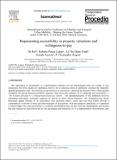Representing accessibility in property valuations and willingness-to-pay
Author(s)
He, He; Ponce Lopez, Roberto; Ferreira, Joseph; Zegras, Pericles Christopher
DownloadPublished version (387.7Kb)
Publisher with Creative Commons License
Publisher with Creative Commons License
Creative Commons Attribution
Terms of use
Metadata
Show full item recordAbstract
The objective of the study is to determine how well different measures of accessibility represent household and market preferences in property valuations. Specifically, the authors explore the appropriateness, advantages, and limitations of personalized accessibility measures [consumer surplus, activity-based accessibility (ABA)] compared to aggregate accessibility measures (gravity-based accessibility). Similarly, the authors compare accessibility measures that account for individuals’ daily activity schedules (ABA) to those that do not (consumer surplus, gravity-based accessibility). Furthermore, the authors consider different approaches to aggregating personalized measures when necessary. Namely, a household’s willingness-to-pay should reflect a summary of the accessibility of its members, and the market price for a property should reflect a summary of the market’s accessibility preferences. The authors conduct their study in the context of Singapore.
Date issued
2019-09Department
Massachusetts Institute of Technology. Department of Urban Studies and PlanningJournal
Transportation Research Procedia
Publisher
Elsevier BV
Citation
He, He et al. “Representing accessibility in property valuations and willingness-to-pay.” Transportation Research Procedia, 41 (September 2019): 617–620 © 2019 The Author(s)
Version: Final published version
ISSN
2352-1465